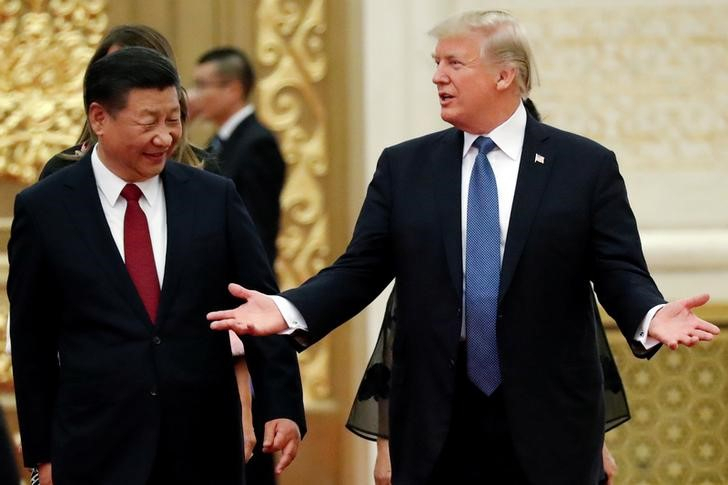China has moved quickly to cushion the blow from U.S. tariffs on its exports, implementing a raft of measures that have helped the world's second-largest economy stay resilient amid a slowdown.
Analysts told the International Business Times that China has more policy options up its sleeves to prop up domestic companies, and will also try to diversify to non-U.S. markets as it girds up for a drawn-out trade war. They expect Southeast Asian countries and Mexico to benefit as American companies look at alternative suppliers.
The trade war between the U.S. and China escalated after President Donald Trump announced 10 percent tariffs on $200 billion worth of Chinese good on September 17, which is set to be raised to 25 percent from Jan. 1, 2019. This is in addition to 25 percent tariffs on $50 billion worth of Chinese products.
In retaliation, China imposed duties on $60 billion worth of U.S. products, and Trump has threatened to impose tariffs on the remaining $267 billion of Chinese imports on further retaliation by China.
Analysts have said 10 percent tariffs on Chinese imports to the U.S. are not significant enough to meaningfully impact the Asian country's economy this year.
Yung-Yu Ma, chief investment strategist at BMO Wealth Management, said China seems to be able to manage its own economic slowdown despite the U.S. tariffs.
"The government is already speeding up infrastructure spending and taking steps to ease liquidity in the financial system," he said. "It won't be full offset to the hit from U.S. tariffs but between these measures and some additional currency depreciation, the blow will be cushioned."
The Chinese economy grew 6.7 percent year-on-year in the second quarter of 2018, the weakest pace of expansion since the third quarter of 2016.
But Yung warned that the stimulus could "add to the imbalances in the Chinese economy and make the eventual cleanup of bad debts more painful down the road."
Arjen Van Dijkhuizen, senior economist at ABN Amro, said Beijing has stepped up fiscal support to offset downward risks from the trade war and even sees an upside risk to growth forecasts of 6.5 percent for 2018.
"As Beijing is stepping up fiscal support and the PBoC (People's Bank of China) is tweaking its financial deleveraging campaign, we think the Chinese economy will prove sufficiently resilient to cope with the downside risks from the trade and investment conflict with the U.S.," he said.
China's central bank, on Oct. 7, announced a cut of 100 basis points in reserve requirement ratio for major banks, releasing about $109.2 billion cash into the banking system.
LIQUIDITY EASING, REDUCE U.S. DEPENDENCY
In a note seen by IBT, DBS said the best policy response from Beijing is to keep its currency stable by further tightening capital controls to curtail potential capital flights on the back of rising U.S. rates.
"Measures such as reduction of corporate taxes, increase in export rebate taxes, and reduced operating costs, are some measures implemented or in the pipeline to help the economy alleviate some pain. Making credit available through liquidity injection and easing credit policies are also measures to boost domestic demand," DBS said in the note.
On the external side, DBS sees China circumvent potential hostility from countries other than the U.S. and seeking deeper cooperation with them.
"China may cooperate more with Europe, Japan and Asean countries, through Belt Road Initiatives (BRI), trade and investments, which all along are strategies for the long haul," DBS said.
"Policymakers may also speed up the design of policies to facilitate faster transition of an export-driven model to a services-based model in the Greater Bay Area. Last but not the least, is to reduce dependence on U.S. as a major export market by diversifying to Russia, Africa and South America," DBS said.
Analysts also think Chinese producers could reroute products to the U.S. via other countries to evade import tariffs. Carsten Hesse, European economist at Berenberg, said: "instead of the product coming (to the U.S.) from China, it could come from Vietnam, for example, to get around the tariffs. This will not fully offset but could partly offset the costs."
SOUTHEAST ASIA, MEXICO TO BENEFIT
Analysts say Southeast Asian countries, whose exporters have manufacturing costs similar to China, and Mexico will be the likely beneficiaries of the U.S. tariff action.
These countries could potentially see more inflows of foreign investment as companies reassess their global supply chains in the medium term, DBS said in its note.
"If U.S. importers find it too expensive to source from China, they could switch their procurement sources to countries like Vietnam, Cambodia, Thailand, Malaysia," DBS said.
Singapore, a regional shipping and financial hub, could also see gains as demand rises for its re-exports, logistics and financial intermediation services, DBS analysts wrote.
Yung thinks most companies will go to Vietnam, Thailand, Taiwan, and Mexico in order to switch production away from China. Mexico definitely stands to benefit because of its deeper business ties to the U.S. "Infrastructure, banking and regulations should continue to improve in Mexico which will lead to even more U.S. expansion there," he said.
But Yung says many more companies will simply be "stuck" and unable to make any meaningful changes in the short-term.
"Over the medium term, there could be some marginal relocation or production increase coming back to the U.S., but that is likely to be small as U.S. companies today are struggling to find labor even for current production," he said.
"Overall, not a large benefit, but not zero either, and U.S. consumers and businesses will undoubtedly have to bear some real costs along the way," he added.


